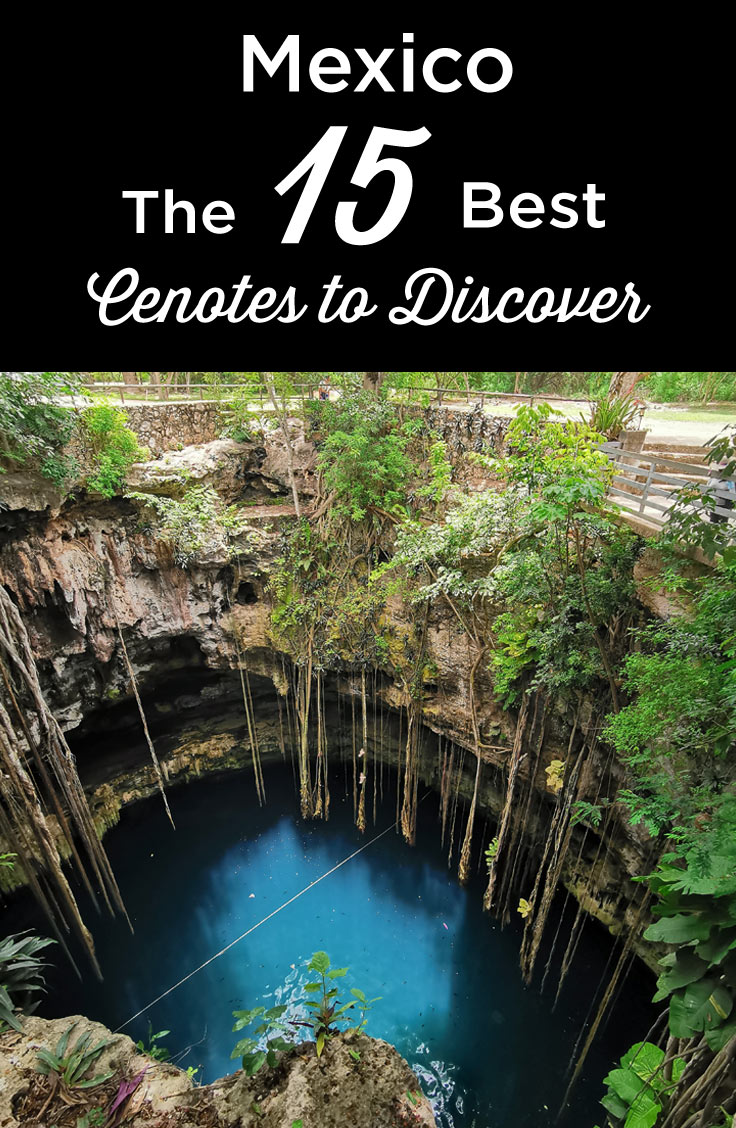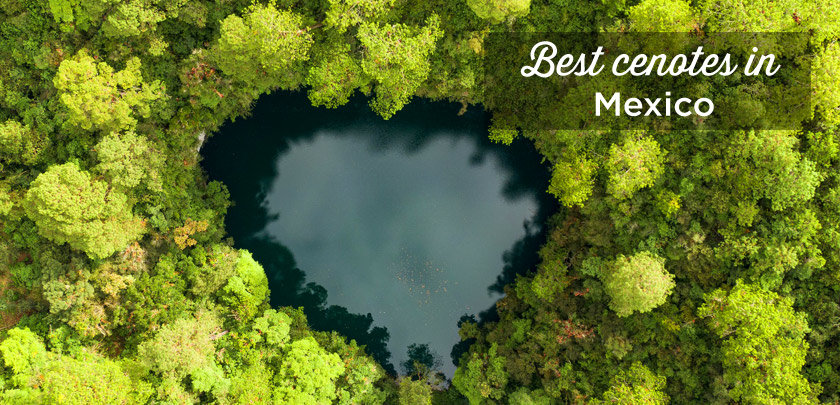My List of the Most Beautiful Cenotes in Mexico
Cenotes in Mexico: The Definitive Guide
If you are short on time and don’t want to read my entire article, here are the best cenotes to visit in Mexico:
- Best cenote in Mexico for families: Cenote Azul
- Best cenote tour: Rio Secreto (click here to book!) – Guided tour to Rio Secreto, light lunch and pick-up at your hotel.
- Best cenote for swimming in Mexico: Cenote Jardin del Eden
- Cenote for diving in Mexico: Dos Ojos and Sac Actun
- Cenote for snorkeling in Mexico: Gran Cenote
- The cheapest cenote: Cenote Zaci
- Sacred Cenote in Mexico: Ik Kil Cenote
- Best cenote with restaurant in Mexico: Hacienda Mucuyché
- Best cenote with restaurant in Mexico: Cenote X’Batún and Cenote Kankirixche
- Most accessible in Mexico without a car: Jardín del Edén, Cenote Escondido and Cenote Azul (15 min by colectivo from Playa del Carmen)
1. Dos Ojos Cenote (Tulum)
Cenote Dos Ojos is one of the most famous and beautiful cenotes in Mexico.
It is a semi-open cenote with clear waters, ideal for families who want to snorkel, as well as for diving enthusiasts who want to explore its caves (with tunnels, stalactites, stalagmites, fossils, etc.).
It is located in Dos Ojos Park, which also hosts the Jaguar, Nicte Ha, El Pit and Los Monos cenotes, which are all very different. It is the perfect place to spend several hours 😉
- Cenote Dos Ojos is located 20 minutes from Tulum, on the road to Playa del Carmen.
- Entrance fee: 400 pesos (200 pesos for children under 12 years old) or 800 pesos for guided dives (with all equipment).
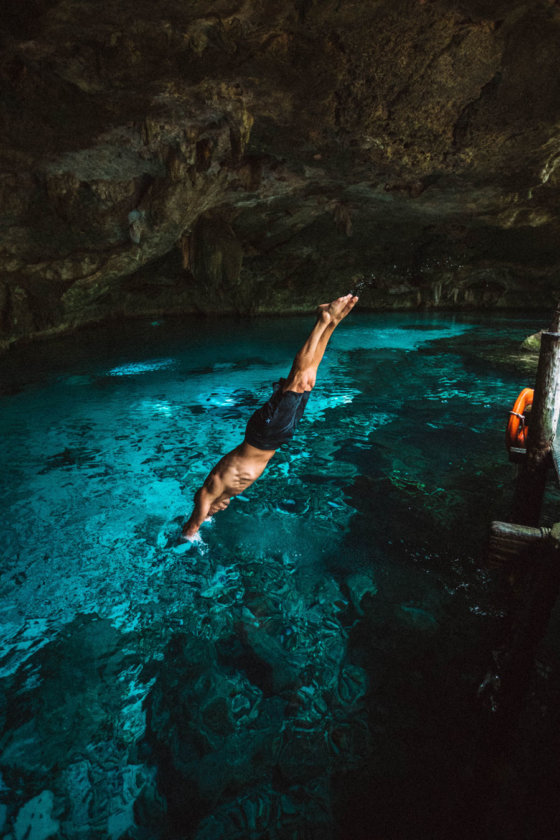
2. Gran Cenote (Tulum)
The Gran Cenote in Tulum is one of the most famous cenotes in the Riviera Maya.
It deserves its popularity with its clear waters that are ideal for diving, its cave and its underwater corridor that connects the two parts of the cenote.
You will also find hammocks under the shade and a large grassy area where you can relax, sunbathe or have a picnic.
- Entrance fee 500 pesos, locker 30 pesos, snorkel gear 80 pesos
- To avoid the crowds and make the most of this tourist cenote, I recommend you get there as soon as it opens at 8am.
- If you don’t have a car, you can rent a bike because it is not far from downtown Tulum. Then if you want, you can continue along Highway 109 to see other cenotes like Zacil-Ha, Calavera and Carwash.
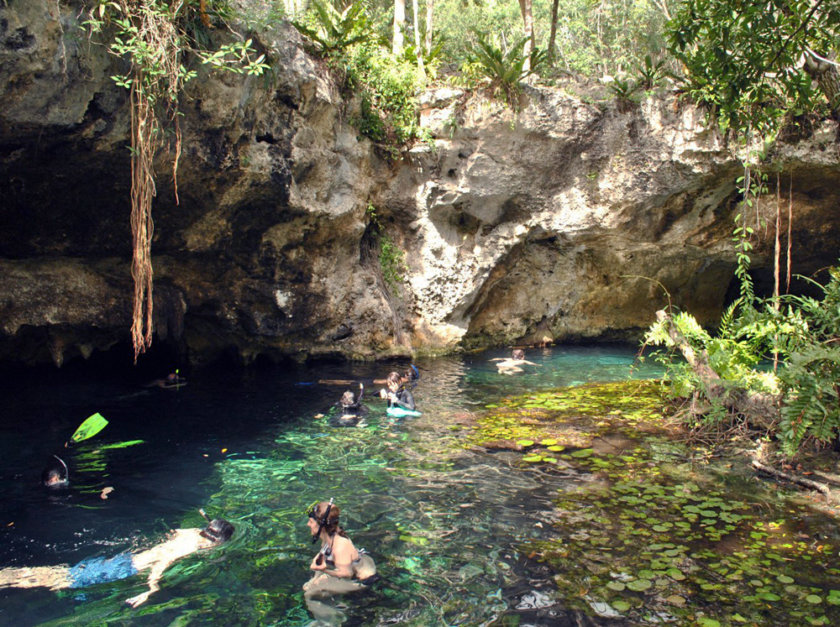
3. Cenote Sac Actun (Tulum)
With its crystal clear waters, large stalactites, colorful fish, bats and fossils, the impressive Sac Actun is not very crowded.
But it’s not just any cenote: research in 2018 revealed that Sac Actun is also connected to Dos Ojos, making it the largest underwater cave system in the world, stretching 217 miles!
It is a dream place to snorkel, dive and observe the jungle fauna of the Riviera Maya.
The entrance fee is a little pricey, but it is worth it since it includes the guide, the equipment, the visit of several cenotes and caves with a mystical atmosphere.
- Entrance fee 650 pesos for the 1h guided tour, snorkel equipment and life jacket
- I recommend you to go by car or cab, but if you go by public transport, you will have to walk 3,7 miles to the entrance
For a complete experience, you can also book this tour to Sac Actun with transportation from Tulum, snorkel in the bay of Tulum (with breathtaking views of the ruins) and the Sac Actun cenote.
Book the tour here:
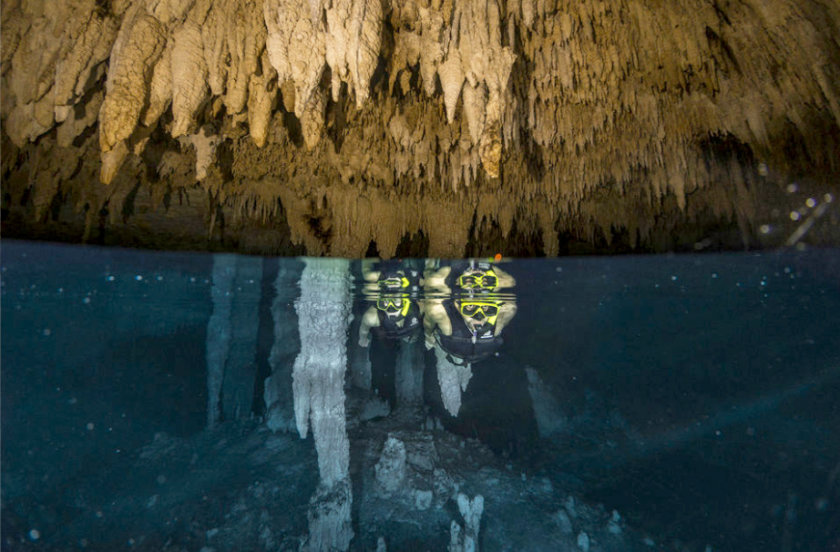
4. Cenote Azul (Playa del Carmen)
Cenote Azul in Playa del Carmen, and more specifically in Puerto Aventuras, is an ideal cenote for families with kids because it is easy to access, with shallow areas and several rocks to sit on in the water.
And that doesn’t mean it’s boring at all: you can jump from a 16 ft wall, snorkel, and have a natural pedicure thanks to the fish that feed on the dead cells of your feet 😉
Another advantage of Cenote Azul in the Riviera Maya is that it is very close to Kantun Chi Park, Cenote Cristalino, Cenote Jardin del Eden, Akumal and Xpu-Ha beach.
- Do not confuse the Cenote Azul of Playa del Carmen with the Cenote Azul of Bacalar which is near the border with Belize.
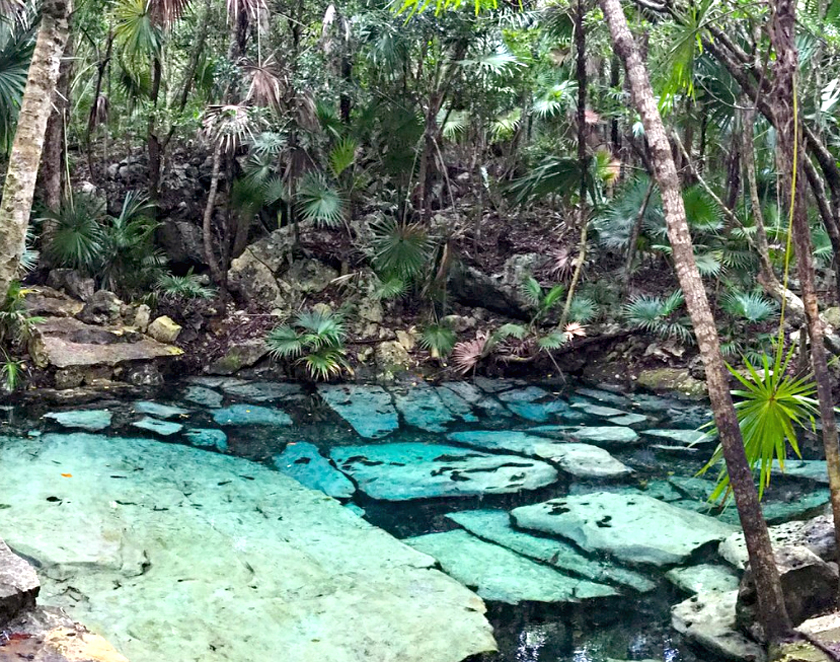
5. Rio Secreto (Playa del Carmen)
Rio Secreto is a unique experience that I always recommend for a Yucatan road trip.
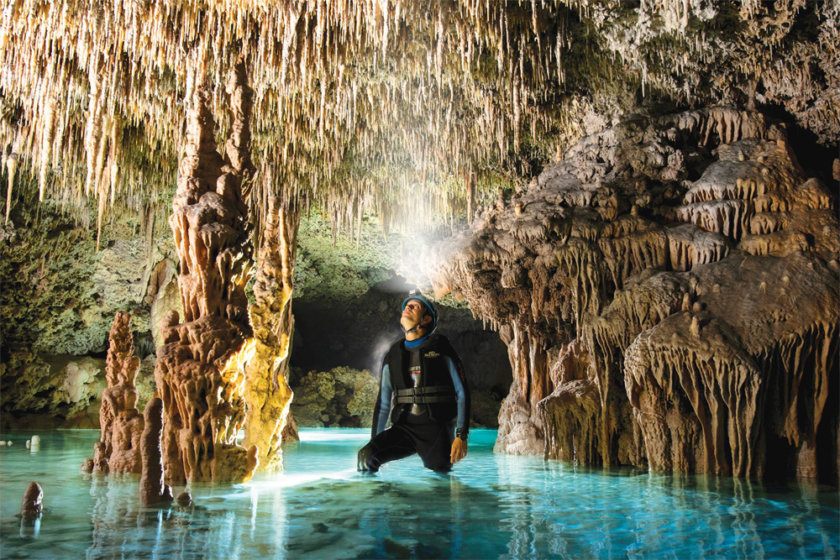
6. Aktun Chen (Akumal)
Aktun Chen is a natural park that offers an immersive nature experience in the Akumal region.
Besides its 10 zip lines, 2 hanging bridges, its wildlife zoo (with monkeys, coatis, kinkajous, etc.) and its underground cenote, it offers a guided walking tour through a cave that is more than 5 million years old.
It is an underground tour of more than 1900 ft that was ranked in the TOP 10 of the best and most impressive underground tours in the world by National Geographic magazine!
- You can book the activities separately, but I recommend you to visit the cave and the cenote.
- 5 min from Akumal, 15 min from Tulum, 25 min from Playa del Carmen.
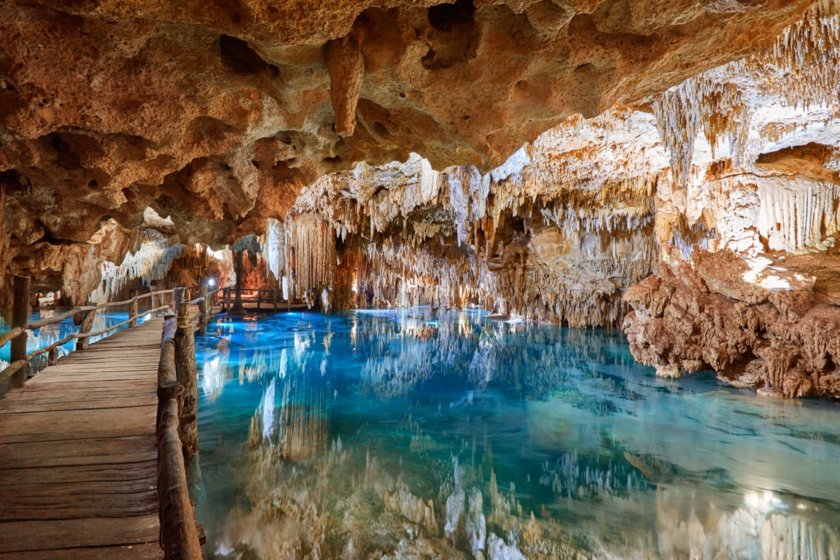
7. Cenote Ik Kil (Chichen Itzá)
Cenote Ik Kil is often called the cenote of Chichen Itza, but it is not in the archaeological site as some agencies suggest.
However, it is just a few kilometers from Chichen Itza and is the perfect place to cool off after a visit under the Yucatan sun.
It is the most touristy cenote in Mexico (always good to know what to expect!), but it is really beautiful with its lush vegetation and offers all the amenities: free parking, restaurant, towels, lockers, life jackets.
If you prefer to visit Chichen Itza on your own, you can get these skip-the-line tickets (click here!) to skip the long lines at the entrance. 😎
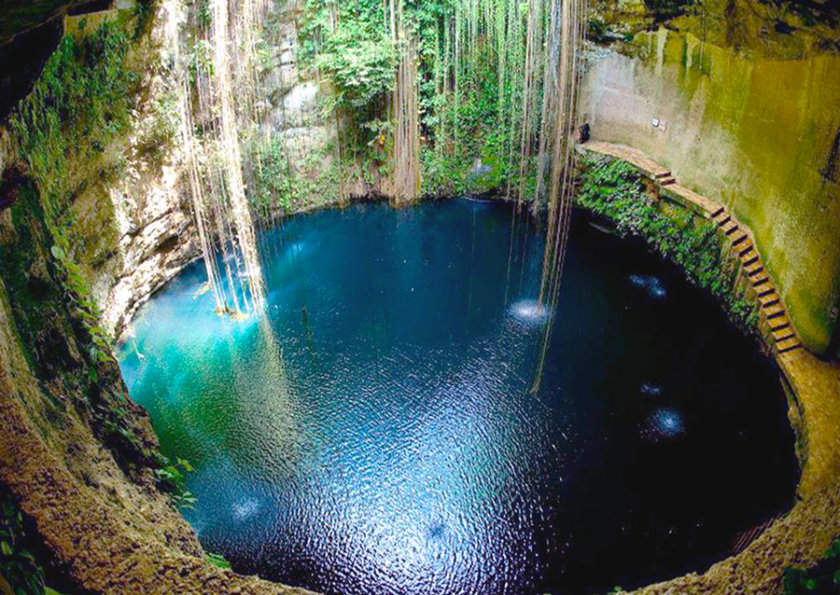
8. Cenote Zací (Valladolid)
Cenote Zací is a fairly large cenote, surrounded by rock walls and plants, which is easily accessed by a stone staircase.
Besides being beautiful, it is very convenient and here is why:
-It has a path around it and platforms at different heights: perfect for the whole family, regardless of age
-It is located right in the center of the city, only 10 minutes from the main square: you can easily include the cenote in a half-day or full-day itinerary in Valladolid
-If you spend 100 pesos at the on-site restaurant, you get free access to the cenote: good and cheap!
- Entrance fee 60 pesos, life jacket included
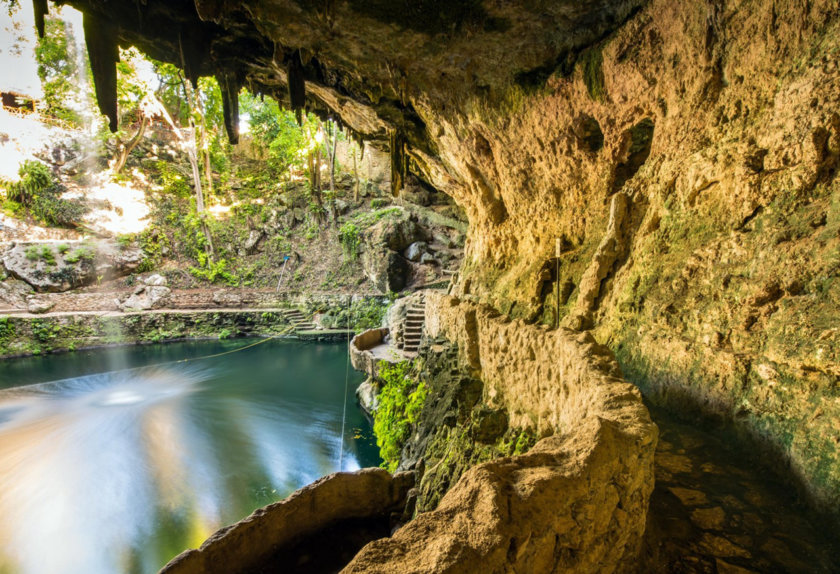
9. Cenote Dzitnup (Valladolid)
The community of Dzitnup is home to two of Mexico’s best cenotes: Xkeken and Samula, often called simply the Cenotes of Dzitnup.
Both cenotes are located in a cave.
In my opinion, the X’kekén cenote is more impressive with its light well, turquoise water and large stalactites, but the Samulá cenote is also worth seeing with its high natural ceiling.
- Entrance fee is 235 pesos (includes the 2 cenotes + life jacket)
- Dzitnup is 15 minutes from the city of Valladolid so it is easy to reach even without a car. You can take a 60 peso colectivo in front of the Casona el Negro Aguilar (Calle 44)
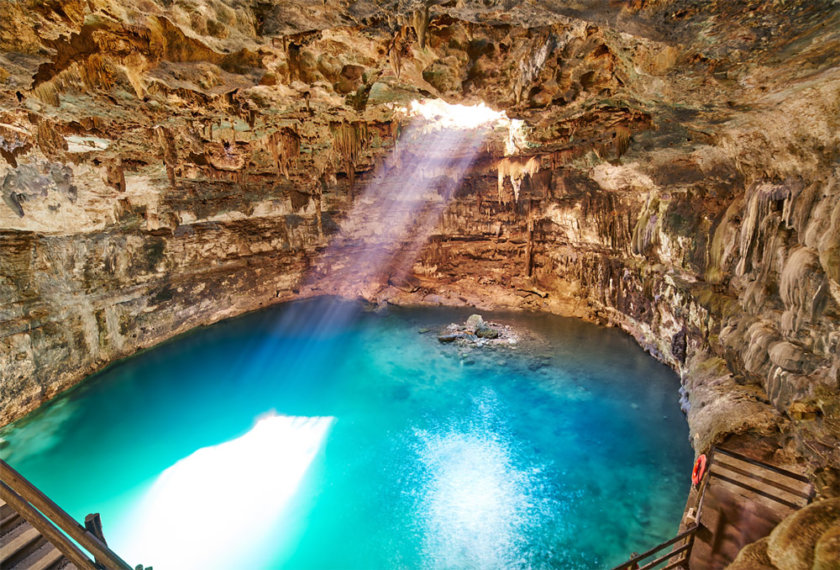
10. Cenote Chihuán (Izamal)
Officially, all cenotes are public and government property, but access to them can be private.
This is the case of the Chihuán cenote, which you can enter through the backyard of a local family’s house.
You descend into a cave with a low ceiling, beautiful rock formations and crystal clear, artificially illuminated waters, perfect for swimming or snorkeling.
This is one of the must-see cenotes in Mexico, but since it is not advertised, there are very few visitors.
It is conveniently located on Highway 180 between Valladolid and Merida, only 30 minutes from Chichen Itza and Izamal!
- The entrance fee is 100 pesos per person, with parking, showers, lifejacket rental included.
- The entrance is 650 ft from Highway 180 between Merida and Valladolid, so it is easy to get there even by bus or colectivo.
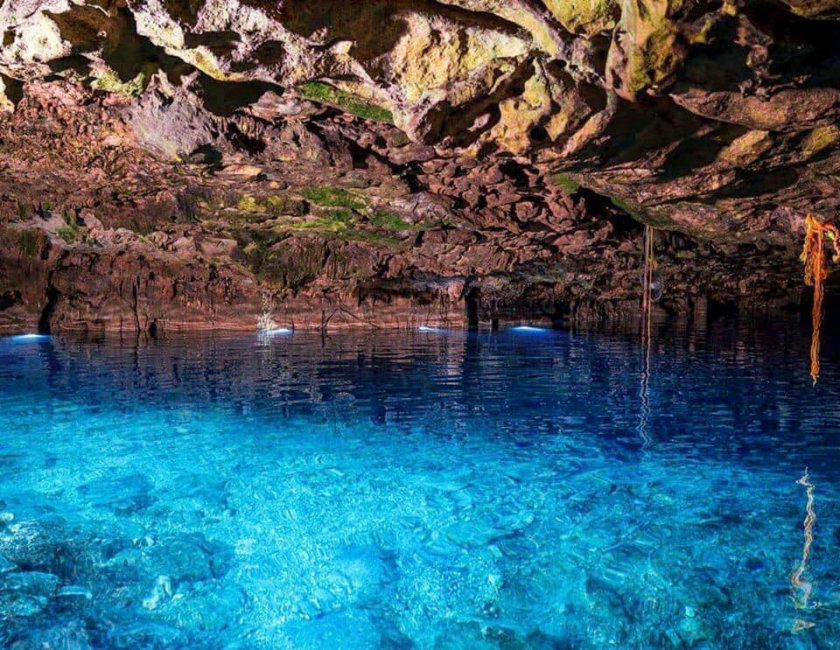
11. Cenote Xbatún (Mérida)
Cenote X-Batún definitely deserves a spot among the cenotes you must visit in Mexico.
I love its wild side, with stone paths, wooden stairs, all surrounded by trees, many roots and plants that are home to various birds.
Besides, it is not very touristy and it is run by a local cooperative.❤️
When you arrive at the traditional village of San Antonio Mulix, you will see a sign that says “Registration for access to the cenotes”.
You have to pay at the small booth next to it and they give you a card that you have to return later in order to pass.
The entrance also gives access to Cenote Dzombacal, a semi-open cenote, not very big, with transparent and shallow water that lets you see different types of fish.
Actually, the X’Batún cenote is much nicer, but both are worth doing.
- It is located in San Antonio Mulix, 45 minutes from Mérida towards Uxmal
- You can rent bicycles, there are also cabins for the night and a camping area
- Entrance fee is 150 pesos (for the 2 cenotes X’Batun and Dzonbacal), bicycle 40 pesos, snorkel equipment 40 pesos, life vest 30 pesos
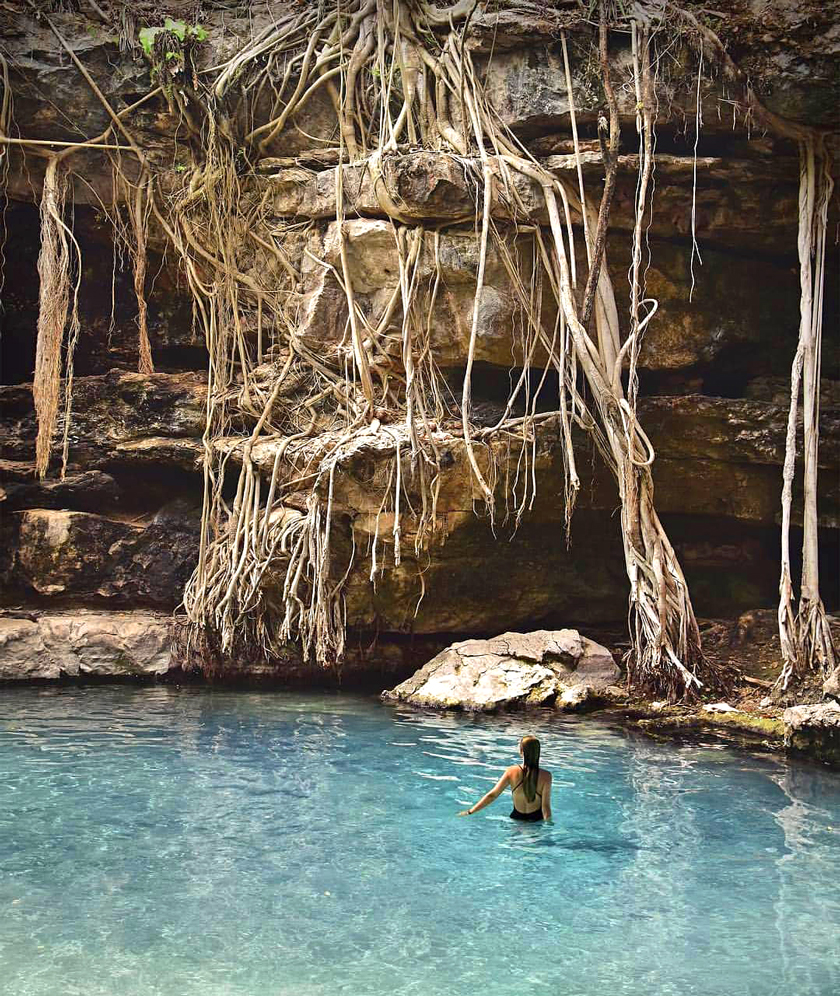
12. Cenote Kankirixche (Merida)
This beautiful cenote in the Mérida region, between the towns of Abalá and Mucuyché, gets its name from the Kankirixche tree, which means “tree of yellow fruits” in Yucatec Maya.
It is located in a semi-open underground cave, with clear waters, large roots and rock formations.
The water depth varies from 16 ft to 160 ft, making it ideal for swimming, snorkeling and diving.
The cenote is run by a cooperative and is very well preserved.
By the way, I recommend two other natural cenotes nearby that are not very touristy: Yaal Utzil (also called Cenote Mucuyche) and Chihuo Hol
- The entrance fee is 150 pesos with a life jacket included
- There is a restaurant on site, but it is only opened on weekends
13. Hacienda Mucuyché (Mérida)
Just 10 minutes from Cenote Kankirixch and a stone’s throw from Cenote Yaal Utzil is Hacienda Mucuyché with a completely different style.
Here, nature has been modified by humans to create two cenotes that are located in an old hacienda (17th century), so that they are connected by a channel surrounded by dense vegetation.
It is a touristy place, not very wild, but the result is really impressive and that is why it deserves a spot in the top of the most beautiful cenotes in Mexico!
The tour lasts about 2 hours and takes you first to explore the hacienda, then to cenote Carlota which is an open cenote.
After crossing the stunning channel surrounded by dense vegetation, walking or swimming, you will arrive at Cenote Azul Maya which is an absolutely gorgeous underground cenote.
The guide will lend you a snorkeling mask, but the water is so clear that you can easily see the bottom even without equipment.
It is a bit more expensive than other places, but the facilities are comfortable, the place is very clean, the guides are very nice and, after the tour, you can enjoy the restaurant and the pool.
Y… not to mention that it is a very photogenic place!
- There are also night tours to see the site illuminated. You have to follow their social networks to find out the dates.
You can click on the name to book (all include pick-up at your hotel and lunch):
- Check out my guide: The 20 best things to do and see in Merida
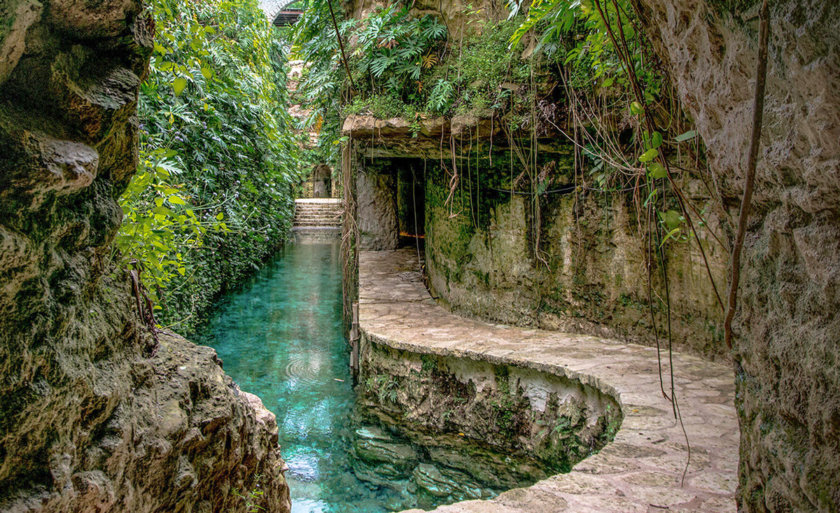
14. Miguel Colorado Cenote (Campeche)
Campeche is the least touristy state of the Yucatan Peninsula and its magnificent cenotes are rarely mentioned!
The advantage of Campeche’s cenotes is that they are quite wild, and the disadvantage is that they have almost no infrastructure (with a few exceptions).
What I recommend if you want to enjoy a nice day activity is to go to the town of Miguel Colorado, 2 hours from the city of Campeche and 30 minutes from Escarcega.
Here you will find 2 cenotes: Cenote Azul is the largest, where you can swim, kayak and zip line.
Continuing on foot less than 0,30 miles into the jungle surrounded by orchids, you then reach the Cenote Los Patos.
It gets its name from the numerous ducks that live there, some endemic, others migratory. Unfortunately, the water is not accessible, but the view is worth it!
- The entrance fee is 150 pesos (with kayak) or 250 pesos with kayak and zip line
15. Chukumaltic Cenote (Chiapas)
Cenote Chucumaltik, “the Hidden Beauty”, is one of the natural wonders of Chiapas, just 40 minutes from the El Chiflón waterfalls and 2 hours from the Montebello Lakes.
This Chiapas cenote offers incredible visibility of 130 ft, making it an ideal place for swimming and snorkeling (don’t forget your mask!).
But it is also a amazing place to dive with its 230 ft depth and its bottom that conceals petrified trees, sulfur chimneys, caves and a sculpture of the Virgin.
- There are several entrances to the cenote, and prices ranges from 30 to 100 pesos
- There is no food on site or nearby, but there are tables in the shade, so bring snacks and water
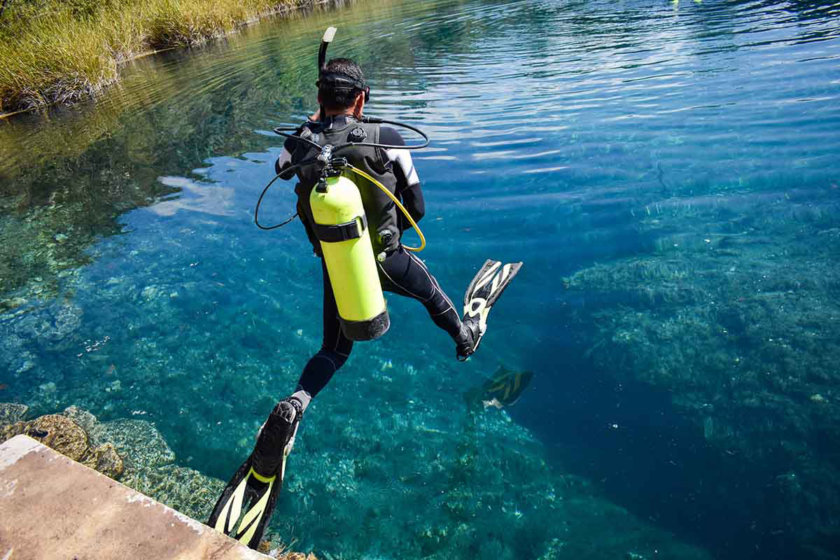
Tourist map of the cenotes of Mexico
Here is a map that shows the most beautiful cenotes in Mexico that you can visit:
The best cenotes by region
If you are looking for the best cenotes in Mexico for a specific region, here are my other guides:
- Best cenotes in Yucatan
- Best cenotes in Tulum
- Best cenotes in Playa del Carmen
- Best cenotes in Valladolid
- Best cenotes near Cancun
Everything you Need to Know about Cenotes
What is a cenote?
The word cenote derives from the Mayan “ts’ono’ot”, which means “cavity with water”.
Cenotes are freshwater wells, many of which are connected to a vast network of caves, tunnels and underground rivers.
The cenotes were very important for the ancient Maya, as they were their main source of fresh water and represented the gateway to the underworld where many gods resided.
For this reason, cenotes were sacred sites where sacrifices and offerings of various kinds were performed.
There are three types of cenotes:
- Open cenotes: these are natural pools surrounded by stone walls, often adorned with vegetation that attracts birds and butterflies
- Semi-open cenotes: these are covered by a rock dome with sunlight filtering through an opening
- Cavern cenotes: these are subterranean cenotes, hidden in caves that can be accessed by a ladder. These are my favorite because you really feel like you are in another world!
What to do in a cenote?
Swimming, snorkeling, scuba diving, kayaking, zip-lining, rappelling, etc.
Activities vary, among other things, depending on the depth of the water, as well as the size and type of cenote.
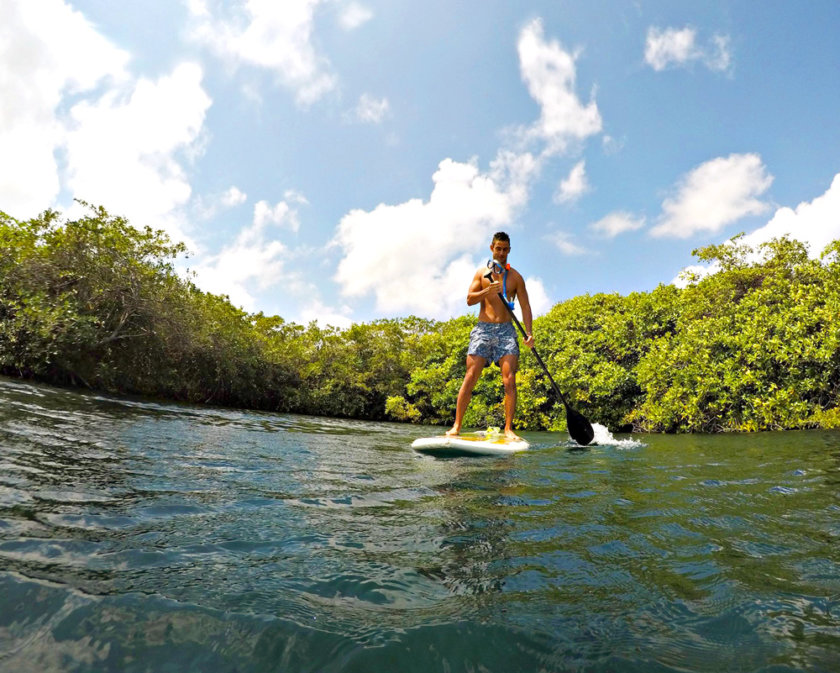
How many cenotes are there in Mexico?
It is hard to get an exact number, but it is estimated that there are between 6,500 and 7,000 cenotes in Mexico, most of them located in the Yucatan Peninsula.
Out of these, about 150 cenotes are open to visitors.
There are also cenotes in Guatemala and Belize.
How much do cenotes cost?
The price of cenotes varies greatly depending on their location.
As the cenotes in the Riviera Maya are much more touristy, the entrance fee is around 200-500 pesos, but others can cost as little as 50-60 pesos.
There really is something for every budget.
How cold is the water in the cenotes?
The water in the cenotes is quite cool, but not freezing.
It can reach up to about 77 °F (25°C), but since the weather is very hot and humid, you might feel cold when you enter the water, and then you will adjust to it.
The temperature of the water also depends on how much sunlight it gets: the water in the open cenotes is warmer than in the subterranean cenotes.
You don’t need a wetsuit for swimming or snorkeling, but if you are going to dive deeper, you might want to wear one.
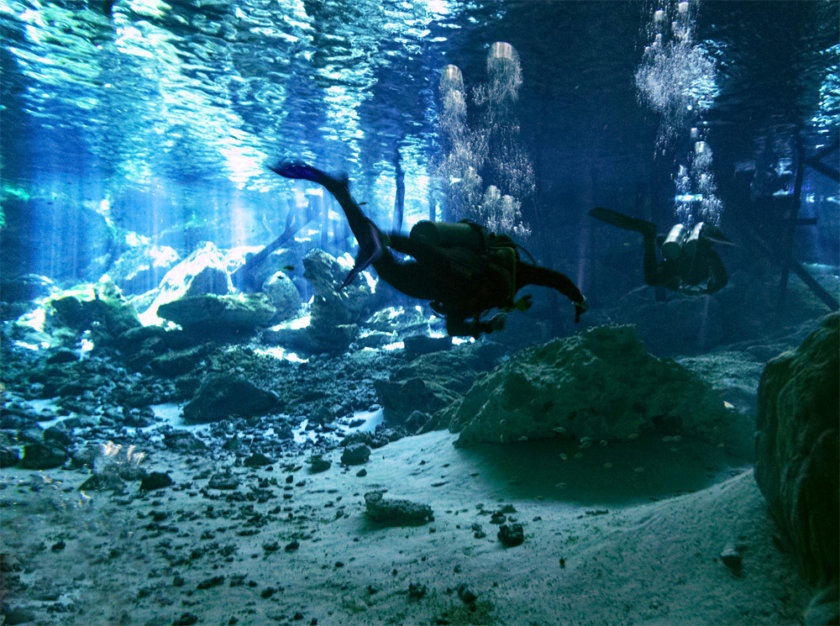
Are the cenotes in Mexico safe?
Yes, they are safe, but of course you should always be cautious because cenotes are fed by underground rivers and, even if the current is very gentle, there can be a suction effect in some places.
It is better to wear a life jacket (usually available for free or at a low cost, depending on the cenote), especially if you are children or anyone who is not very confident in swimming.
Also, because it is not the sea, there is no salt in the water: you don’t float here!
There are no crocodiles or other animals that could harm you. There are only some small fish, turtles and sometimes bats.
When is the best time to visit cenotes?
If you are visiting a very popular cenote, go in the morning before 10:30 am or after 3pm to avoid the crowds. The time of day will really make a difference in your experience. 😉
Also keep in mind that cenotes are usually crowded with local families on Saturdays and Sundays, so I suggest you go on a weekday to have more peace and quiet.
What to bring to a cenote?
- Bathing suit
- Cash: it is very important because cards are not accepted. So bring enough money for the entrance fee to the cenote, and extra expenses (locker rental, something to eat, etc.)
- Waterproof case for your phone: you will be able to film and take pictures underwater with your phone. They are easy to find for sale all over the Riviera Maya.
- Sandals and comfortable shoes: to get to the entrance of some cenotes, you may have to walk along a rocky path.
- Aquashoes: you can actually wear just sandals, but the cenotes are surrounded by rock, and it is much more comfortable for your feet to wear aquashoes! You can buy them for a good price at Walmart or Soriana.
- Towel: we tend to forget, but towels are not provided in the cenotes
- Snorkel Mask and Snorkel Tube: very useful to fully enjoy the cenote and be able to observe underwater! You can easily buy them at Walmart or Soriana.
- Enough water: cenotes are usually located in hot and humid areas, so it is important to stay hydrated.
- Snack: as I said, in a cenote you don’t float, so it is more tiring to swim and dive than in the sea. This will make you hungry.😋
My last tips for visiting cenotes in Mexico
- Avoid bringing valuables, as lockers are not always available
- Cenotes (subterranean or semi-open) are the perfect activity when it rains. However, the water might not be crystal clear, but a bit cloudy.
- Be a responsible traveler: use only biodegradable sunscreen, always remember to shower before entering a cenote and never touch the stalactites or stalagmites. This is very important.
- Bring a plastic bag to make sure you return with your trash. In Mexico, there are very few trash cans!
Rent a car in Mexico
Renting a car is for sure the best way to explore Mexico and make the most of your stay!
To rent a car, personally, I always use Booking.com Cars, for a few reasons:
- You can easily compare the rental cars prices between all the agencies: for sure the easiest way to find the best rate!
- Cancellation is often offered free of charge: no need to worry if you change your mind
- Booking Cars offers full insurance coverage at a lower price than the rental companies, so it’s an instant saving with no effort
Simply click on the green button to find your rental car at the best price:
Find your flight at the best price
To save money on flight tickets, you can use our flight comparator for Mexico, in partnership with Skyscanner: it’s the guarantee to pay the best price for your international and domestic flights!
🚗 Rent a car
🗽 Book entrance tickets and guided visits
🏄 Book your sports activities
🌍 Take a travel insurance
🙎 Book a tour
✈️ Book your flight
You’re traveling in Mexico? These articles will help you!
Discover all my articles about Mexico: All my articles to help you plan your trip to Mexico are listed there.
- The 35 Best Things to Do in Mexico
- Yucatan Peninsula: Top 20 things to Do and See
- Playa del Carmen: Top 30 Things to Do and See!
- Cancun: the 35 Best Things to Discover
- Tulum: 21 Best Things to Do + All My Best Tips!
- Itinerary: 10 days in Mexico – Mexico City, Chiapas and Yucatan
- Itinerary: 2 weeks in Mexico – Best itinerary to discover the Yucatan Peninsula and Chiapas!
- Itinerary: 3 weeks in Mexico – Mexico City, Puebla, Oaxaca, Chiapas, Campeche, Yucatán and Riviera Maya
- Itinerary: 1 month in Mexico – My Epic 30-31 Days Itinerary from Mexico City to Cancun
- Road trip in Mexico: The best itineraries for 10, 15, 21 days and a month
- Itinerary: 1 week in Yucatan – The Ultimate 6, 7 or 8 days Itinerary
- Itinerary: 10 days in Yucatan – Best Itinerary for 9, 10 or 11 Days in Yucatan
- Itinerary: 2 weeks in Yucatan – Epic Itinerary + All my Best Tips!
- Itinerary: 3 weeks in Yucatan – Best things to do in 20-21 days
- Itinerary: 1 month in Yucatan – Yucatan Peninsula in 29, 30 or 31 days from Cancun
- Road trip in Yucatan: The best itineraries for 7, 10, 15, 21 days and 1 month
You’re using Pinterest? Here is the picture to pin!
